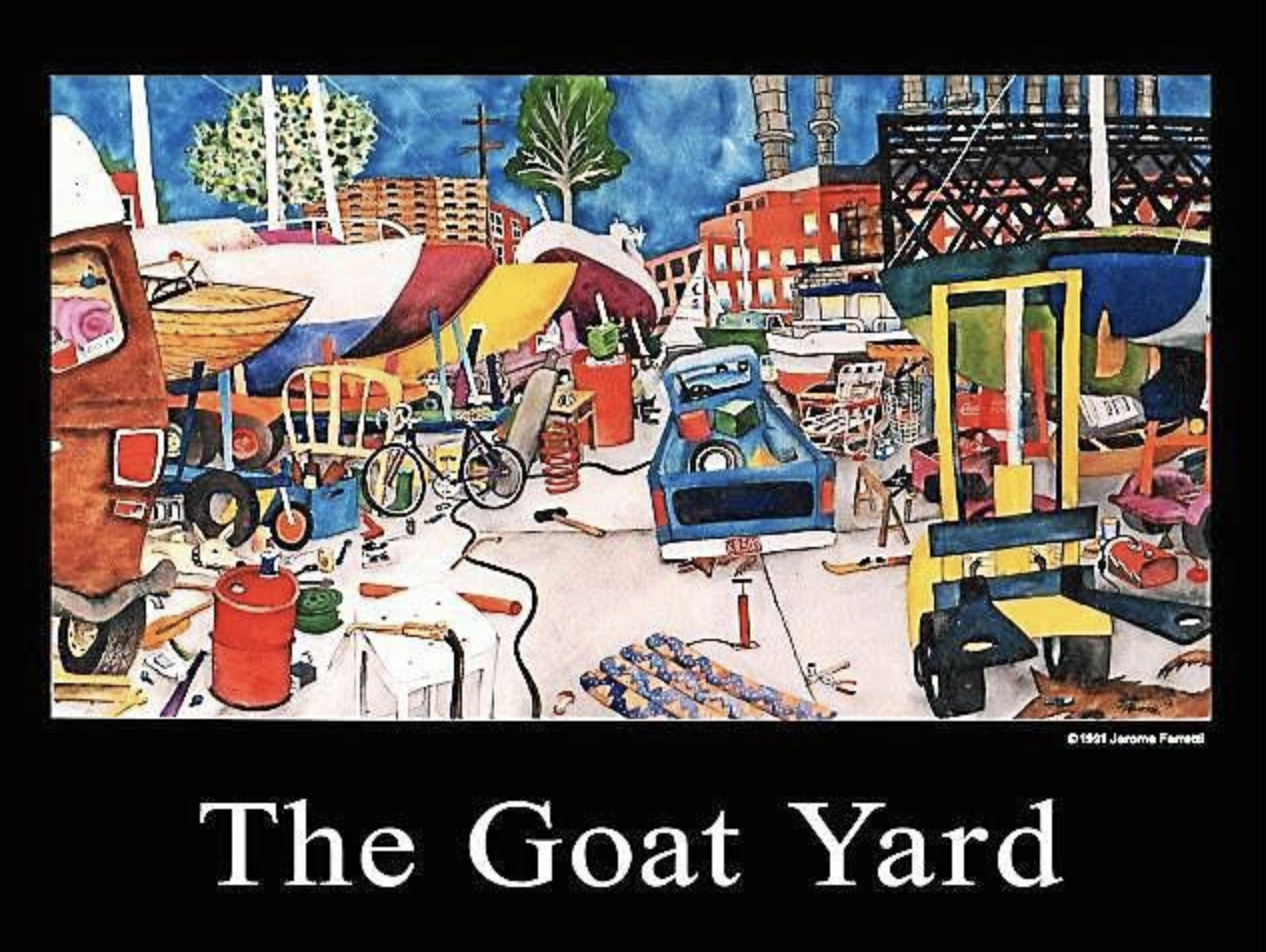


Lakeland Boating - January 01, 2021
From the late 1970s into the 2010s, sailors delighted in an extraordinary boat yard near the foot of St. Jean on the Detroit River, where all worked hard at having fun. They raced Detroit’s fleet of Crescent sloops while hailing the battle cry “Huy, huy, harya.” They tinkered with the toys lying around there: a tug boat, school buses, motor boats, antique cars, a fire truck. They built and launched an aqua-car.
The yard’s official name was Detroit Boat Works, but known as “the Goat Yard” among Detroit’s sailors since the 1980s. Operating the yard for more than 30 years was the memorable Stephen Hume.
“Stephen’s agenda was fun,” says Sue McDonald, Hume’s parter from 1984 until his death in 2013.
Captain Nemo
When Hume considered getting McDonald a horse for her birthday, he solicited the advice of his sailing buddy, Charles, who had served in the Hungarian Calvary. Charles told Hume that if he brought a horse to the boat yard he would report him to the Humane Society, then advised, “Get her a goat.”
Hume bought two goats in Detroit’s Eastern Market: a female, named Tugboat Annie, and a male, Captain Nemo. Unfortunately Tugboat Annie was chased by a dog into the river, where was caught under a dock and drowned.
“Poor Nemo was so sad,” recalls McDonald.
Nemo quickly fell in as a beloved pet of the boat yard gang. He loved to eat — leaves, cigarettes, cigars, stickers from car doors. He ate whatever appealed to his appetite, including dozens of fishhooks one day. Detroit sailors say one instantly became Nemo’s friend or foe.
Bryan Brieden, 58, who began hanging out at the yard in 1986, recalls, “You got to know the goat. Otherwise you were gonna get in trouble, cause that goat liked to fight. I remember one day. We were going out sailing, and one guy was bothering the goat. The goat was able to figure out what car was his. Some say he got on the guy’s hood because it was warm, but we all had warm cars. When we came back in, the goat was sitting on that guy’s Porsche.”
Nemo’s undoing came in early 1991, when he was chased onto the ice of the Detroit River by wild dogs, who caught up to him and killed him.
Hume and his brothers had his head stuffed and mounted in the Detroit home he shared with McDonald
Detroit’s Great Marsh
The Goat Yard is part of the Grand Marais stretch of coast along the Detroit River and lower Lake St. Clair. Isabella Lothrop described this way in a November 11, 1922, Detroit Saturday Night article:
“It began at Connor's Creek and rolled away in a prairie-like sweep of coarse marsh grass, to the river on one hand and the distant purple woods on the other as far up as Fox Creek, its northern boundary. To the casual glance it appeared to be a piece of waste moorland, soggy and unproductive, but woe to the unwary who ventured upon its treacherous surface. It was an unaffordable morass full of quags and sloughs and miry bogs.”
In the eighteenth century, French settlers filled the swampy ground to cultivate ribbon farms, the genesis of many Eastside Detroit and Grosse Pointe street names. Well into the nineteenth century, Grand Marais homesteads continued to emerge along the coast from Waterworks Park up to Cadieux Road. In the early twentieth century, real estate developers solicited families to move into new riverfront communities being built on coastal acreage of filled marshland, including the Goat Yard’s peninsula. These historic neighborhoods were razed during the late twentieth century, making way for new developments, such as the Morgan Waterfront Estates sitting directly east and across a canal from the Goat Yard.
An Agenda of Fun
After rented the yard more than three decades, Hume was finally able to purchase the property a few months before he died.
“Stephen’s agenda was fun,” says McDonald. “No one worked harder at having fun. And he was a magician with an engine.”
The couple met in 1984 on The Hill in Grosse Pointe Farms, where McDonald worked as a newspaper reporter and Hume had a business — a bike shop called Detroit Velocipede. They both loved sailing.
The Goat Yard was known as the home of Detroit’s exclusive Crescent sloops, built in from 1953 to 1974. It is the oldest one-design class of fiberglass racing sailboats and remains active today. Like nearly every Detroit sailor, McDonald has memories of racing Crescents with Hume.
McDonald recalls, “After we raced together one-half of a season, Stephen said, ‘Sue, every boat needs a captain. And our relationship can’t handle a captain. Buy your own boat.’ So I got my own Crescent.”
Detroit Sailors still share vignettes about the lovely chaos at the Goat Yard. In 2016, Michael Pfaindtner and Kimberly Stricker released the documentary The Goat Yard, which captures the essence of Hume’s stranger-than-fiction Goat Yard years.
Brieden recalls, “It was a throw-back to the 70s. There were a lot of hippies there. They had dogs and cats. There was a goat. There were chickens.”
He was part of a group that developed Detroit’s Star sailboat fleet at the Goat Yard. The group set up a hoist, parts crib, J-boom and foundation, and floating docks and dug an 18-inch deep trench to run a power line.
“Stephen Hume exploited us,” Brieden laughs. “He made us do all the work, but what he did was give us a bargain. We couldn’t have gone anywhere else.”
“Stephen was a really nice and fair person,” says McDonald. “I learned a lot about how to treat people from him.”
She adds that Hume referred to the yard as adult day-care. He often called out, “Hey, it’s a pleasure boat. Stop working on it. Go sail on it. I heard that a million times. He firmly believed that adults need to have fun, too.”
Great Work
In early 2020, the yard’s owners, Alex Hume, 29 — Stephen Hume’s nephew — and Hanson Bratton, 56, officially gave the yard its true name — Goat Yard Marine, LLC. Subject of a nuisance abatement order by the city of Detroit, the yard required major tidying up, which Hume and Bratton began in 2018.
“It’s so crazy to look at pictures of then and now,” says Hume, who was close with his Uncle Stephen. “I remember all the old buildings, all the nooks and crannies.”
Recalling the extra six acres at the south end, Hume says, “When I was real young, it was all wooded forest. (Uncle Stephen) had a big area that was full of wooden boats. … To me, it was my version of Narnia.”
Hanson laughs, “To me, it was like a scene out of RoboCop, or Mad Max. It was pretty wild over there. Very industrial. I didn’t know anything about the history or ownership then. I was just invited over for parties.”
Hume is too young to remember Nemo, but has been told that the goat liked to knock him down.
“The goat (head) is sitting on the kitchen wall at my house now. It was a little surprise to my wife,” he laughs.
Two additional Goat Yard sacred items retained are the original Crescent hull mould and a school bus Stephen Hume turned into the School Bus of Rock, equipped with Hammond B-3 organ.
In addition to clearing the yard, Hume and Bratton concurrently managed infrastructure and equipment projects, including installing a seawall and lift well, setting up a travel lift, running power and gas, constructing indoor facilities, and refurbishing the yard’s old tug boat.
The Queen City
Rumor had it that Stephen Hume had acquired the large antique tug boat on trade.
“I guess that’s what you’d call it,” says McDonald, “because the guy was paying him storage and he just turned around and gave the guy all the storage money.”
The tug became the Goat Yard club house.
“My kids all got to go skating on the canal off the tug boat,” says Brieden, “because Stephen would have at least 50 pairs of ice skates on the boat. And he built a cool little gang-plank. … There were a couple really epic hockey games there.”
When Alex Hume and Bratton acquired the yard, they faced a city order to remove the tug and left with two options: cut it up for scrap or move it for restoration. They chose the latter option.
In May 2019, the tug was moved a short distance east to Bayview Yacht Club, where it was restored for use as a temporary BYC club house, while the club’s permanent structure was being rebuilt. In November 2019, the tug opened for drinking, dining, and dancing, just as sailors had gathered there years earlier. Built in 1911 as “The Polana,” the tug was transformed into the Windsor river restaurant “Queen City” in 1980, years before being moored at the Goat Yard.
Bratton and Hume, with the help of BYC members, restored the tug and its name “Queen City.” It will serve as the BYC club house until Spring 2021, when Hume and Hanson will have to find a new home for her.
One of the items adorning the bar of the Queen City is Stephen Hume’s electric guitar, which he used to play one song: The Star-Spangled Banner.
“He played it (The Star-Spangled Banner) all the time,” laughs McDonald. “When someone was leaving to go out sailing. When someone was coming in from sailing.”
One-Stop Service
In spring 2020, Goat Yard Marine began offering sailboat services year-round: haul-out up to 40,000 pounds, 15-foot beam; launch; rig stuffing/unstuffing; fiberglass repair; bottom-painting; rigging consulting and installation; and shrink-wrapping.
Thomas Hardware, which has served Detroit sailors for more than 100 years relocated to the yard. The business is well-known in the area for recommending, procuring, and fitting up sailors with what they need for cruising or racing their boats. Much of Jones’ work is face-to-face consulting.
“I used to go to people’s boats and work there,” says owner Todd Jones, who calls himself a “sailing concierge.” “Now we have the advantage of people being able to bring their boat here. We can take the mast down, go through the whole thing. Then Alex has the other services — bottom paint, fiberglass work, winter storage, all the other stuff. It’s kind of one-stop shopping.”
Jones spent many Tuesday nights at the yard during the 1990s and 2000s racing in the Crescent class.
“(The yard) is a big piece of Detroit history. I’m glad they turned it around,” he says.
Hume and Bratton plan to expand yard acreage and sailboat services, but those details are undefined.
McDonald says Stephen would be so proud of his nephew and impressed with the work he and Bratton have done in continuing the yard’s mission of sailing fun.
“I think they’re filling the niche of really high-end service for fine racing boats,” she says.
“We want to be a one-stop shop for the Detroit sailing community,” says Bratton, “but it’s a work in progress. We just have to see where it goes.”
“We want to do anything to help people get on the water and stay on the water,” adds Hume
Goat Yard Marine is open daily from 8:30 a.m. to 4:30 p.m. Monday through Friday and 10 a.m. to 2 p.m. Saturday. Call (313) 886-6094 for Thomas Hardware’s hours or to make an appointment.
For more information about the yard’s history, see The Goat Yard: https://youtu.be/WvcN05pKWdc. For more about Nemo, watch see https://youtu.be/nApKu40WdII.